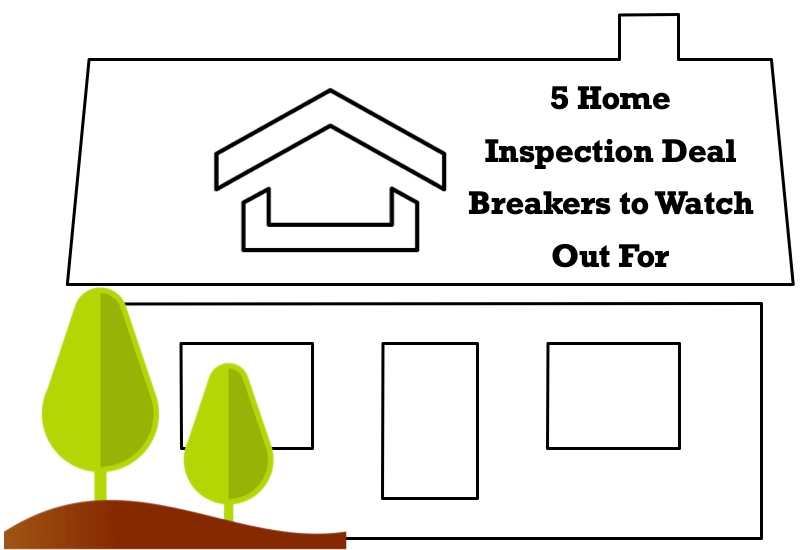5 Home Inspection Deal Breakers to Watch Out For. Haunted houses may be a great idea for your next Halloween extravaganza but living in such a home is nothing less than a nightmare. We are not talking about any paranormal activities or those horrifying scenes you might have watched in your favorite horror movies. We are referring to bigger problems here.
When you buy a new home by investing your hard-earned money, then the idea of spending even more money to make it inhabitable might be the last thing on your mind. To avoid such an unfortunate situation, conducting a home inspection is of paramount importance before buying a new property.
The main goal of a home inspection is to go beyond what is visible to the naked eye and uncover the hidden defects in the property. Sometimes, the seemingly minor defects can lead to severe large-scale problems in the near future. A professional home inspection can help you detect all the existing and potential problems in the property to avoid any nasty surprises in the future.
While conducting a home inspection is not a mandatory requirement, this cost-effective step can help you save a lot of money and trouble in the long run. It also allows you to renegotiate the deal or simply back out if the property is riddled with serious problems.

1. Troublesome Water Damage
Water damage can spell disaster for any home. Water infiltration can lead to all sorts of problems in your home including mold growth and even structural issues that are often difficult and expensive to fix. It can also lead to foundation problems that can compromise the structural integrity of your home.
Therefore, when inspecting the exterior of the property, check it for drainage issues like a flooded yard or standing water near the home. In addition, look out for rot around the wooden components including the windows and door frames. On the interior, keep an eye out for swollen drywall and peeling paint.
2. Severe Structural Damage
Not only structural problems are expensive and difficult to repair, they can also be extremely dangerous. While it’s common to see some settling over the years, if there’s major shifting in the property, it usually indicates serious problems in your foundation. Some of the telltale signs of structural damage include cracks on ceilings and walls, cracks in exterior masonry and chimneys, sloping or sagging floors, and inoperable windows and doors, among others.
3. A Deteriorating Roof
A high-quality shingle roof doesn’t show any signs of wear and tear for at least 20 years. However, if your roof is nearing the end of its service life and has started showing any signs of damage, make sure to contact professionals right away.
Also, keep an eye out for red flags like missing, curling, or cracked shingles, rusted or loose flashing, dark stains on the roof, moss and mold, water stains on the ceilings, walls or attic, and a sagging or drooping roof, among others.
4. Faulty Electrical Wiring
Just like in scary movies, flickering, dimming, or buzzing lights in any home are an indication that something unfortunate is going to happen. These lighting defects might be caused by faulty electrical wiring. So, make sure to conduct a thorough electrical inspection.
A few warning signs include unusually hot outlets, ungrounded receptacles, a strange odor emanating from fuse box or breaker, malfunctioning GFCI outlets, and frayed or damaged wires, to name a few. Most of the older properties are fitted with outdated knob and tube wiring. If that’s the case with your new home, make sure to replace it immediately because many insurance companies don’t insure such homes.
5. Bad Plumbing
Faulty plumbing can seriously jeopardize your health and safety. Fortunately, there are some warning signs you can look out for to prevent and fix your plumbing issues as soon as possible.
Firstly, examine the kind of pipes installed in the home. For instance, most of the older homes have galvanized pipes that may corrode after a decade or so and may result in lead contamination in your drinking water. Another common material for pipes is Polybutylene (PB). These pipes also tend to corrode and are susceptible to failure after a certain period of time.
The second step is to look out for any signs of pipe leaks. If left unattended, leaks can lead to mold growth, structural damage, and rot issues in the home. Even seemingly minor problems like a leaky faucet or low water pressure can indicate pipe blockage. This usually happens when incorrectly sized pipes are installed. Lastly, make sure to get the sewer inspected for any obstructions like root growth. This will allow sewerage to flow properly to the main sewer.
A general home inspector usually has the skills and knowledge of all the major issues in a home. However, if you’re looking to detect even the most subtle and potential defects in the property, getting in touch with the specialists in the above mentioned areas may be a better option.
So, if you’re planning to buy a home, get in touch with our experts today. Our roofing and home inspection services can help you make the most of your investment. For more information, get in contact with Louisiana Landsource today. Didn’t find what you’re looking for in Louisiana today? Check out our sister site at Texas Landsource for all top land listings.
